If you often wear rain jacket, rain pants or other waterproof clothes, you probably noticed that the performance of these garments decreases with time. While your new rain jacket kept you dry for hours, it can’t withstand more than half of an hour of rain after half a year of intensive use. That’s most often because the garment’s DWR (Durable Water Repellent) coating has been washed away. The good news is that you can re-waterproof your garments and thus prolong their lifespan. Re-waterproofing is fairly inexpensive and you can do it home without any special skills. All you need is a bottle of DWR spray which costs less than $20. DWR ensures that your garments don’t absorb the water but, as the name suggests, repel it. Applying DWR is a very easy and efficient method to increase the waterproofness of garments. However, this method will obviously only work on undamaged garments. There is no spray that will magically fix a torn or worn-out fabric.
In the following I’ll explain how to re-waterproof your clothes. Before writing this article, I re-waterproofed my Montane Atomic rain pants which stopped repelling the water. For re-waterproofing I used the Eco Textile Proof DWR spray from the Swiss brand Toko. But let’s start with the basics and clarify which clothes can be re-waterproofed with DWR, why and when you should re-waterproof your clothes with DWR and which brands make DWR sprays.
Table of Contents:
- Which clothes can you re-waterproof with DWR?
- Why and when should you re-waterproof your clothes with DWR?
- Which brands make DWR sprays?
- How to re-waterproof your clothes with DWR?
- Conclusion
Which garments can you re-waterproof with DWR?
DWR should be applied only to garments that were initially treated with DWR. These garments are rain jackets, rain pants, softshell jackets and some winter jackets. Nowadays, basically every high-quality garment that is designed for weather protection is treated with DWR.
If you are not sure whether your garment was treated with DWR or not, check out the product’s technical specifications. You can usually find technical specifications on the manufacturer’s website. Nevertheless, you can expect that every shell layer has a DWR coating.
Why and when should you re-waterproof your clothes with DWR?
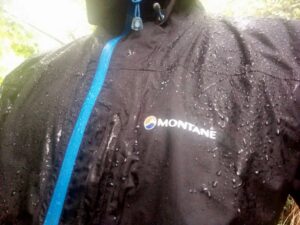
The garment is still water-repellent (see water droplets on the fabric) – no need for re-waterproofing!
DWR creates a hydrophobic (water-resistant) coating on the fabric. Therefore, DWR treated garments repel the water. If the fabric doesn’t repel the water, it will eventually leak because no membrane is 100% waterproof, despite the promises from brands like Gore-Tex. In case that the garment doesn’t repel the water, it also becomes much less breathable since the moisture from the inside (perspiration) can’t escape to the outside. It gets blocked by the water on the outside of the fabric.
DWR is applied to waterproof and water-resistant garments during the manufacturing process, but it eventually washes out and needs to be reapplied. If you see that your garment is soaking up water, especially in light rain, it’s time to reapply DWR.
If you want to avoid reapplying DWR every several months, I recommend that you don’t wash your rainwear in a washing machine or with a detergent. Detergents accelerate DWR loss. I typically hand wash my rainwear gently and only with water to avoid washing out the DWR coating.
Which brands make DWR sprays?
The most popular brands that make DWR sprays are Nikwax, Toko and Grangers. These brands make DWR sprays as well as DWR laundry detergents. I decided to go for a spray since I don’t want to put my delicate rainwear such as the super thin Montane Minimus jacket in the washing machine. I’d rather apply it manually and see that all areas are covered evenly.
How to re-waterproof your clothes with DWR?
Before applying DWR, read the instructions on your DWR spray. However, the process is pretty much the same for all DWR sprays.
First you should wash the garment to remove dirt and body oils since these will prevent the DWR from sticking to the garment properly. Some DWR sprays like the Toko Eco Textile Proof, which I used, require that the garment is dry before the application while others require that the garment is damp (Nikwax and Grangers). Verify what your choice of DWR-spray requires in the respective instructions. Then hang or lay out the garment flat and start spraying it from 4 to 10 inches away (10-25 cm). Note that the DWR should be applied only to the outer side of the garment, not the inner. I recommend that you do the application outside in dry still weather or in a well-ventilated room because inhaling DWR causes dizziness. It might also be smart to wear a pair of safety glasses since DWR can cause eye irritation.
After you applied DWR to the entire outer surface of the garment wait for several minutes and then remove any excess liquid with a damp cloth. It is very important that you remove the excess liquid as otherwise you will have ugly white spots all over your garment. When the excess liquid is removed, leave the garment to dry naturally for several hours – do not put it on a radiator or tumble dry. Now, your garment should be again waterproof.
Conclusion
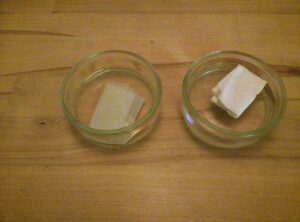
Do DWR sprays really work? Left is a piece of paper without DWR treatment and right is a DWR treated piece of paper.
So, do DWR sprays really work? Yes, they do. To prove this, I conducted a very simple experiment. I took two identical pieces of toilet paper and I sprayed one with the Toko Eco Textile Proof DWR spray and let it dry. Then I put both pieces in each their bowl of tap water. As you can see on the image the piece sprayed with DWR didn’t soak up water while the other piece absorbed the water in seconds and sank to the bottom.
DWR is an easy, efficient and inexpensive method to rebuild water resistance of your garments. My Montane Atomic rain pants restored waterproofness after I sprayed them with the DWR. However, they indeed aren’t as waterproof now as they were three years ago when I bought them. The fabric has unquestionably been worn out and no garment lasts forever if you use it on a regular basis. This is especially true for rainwear which is nowadays made of super delicate fabrics in order to be lightweight and pack small. Nevertheless, if your garment is losing waterproofness and doesn’t have any visible damages, I do recommend applying DWR to it. It’s very likely that this will solve your problem with waterproofness.
I’d love to hear about your thoughts on re-waterproofing clothes. Write them in the comments section below.
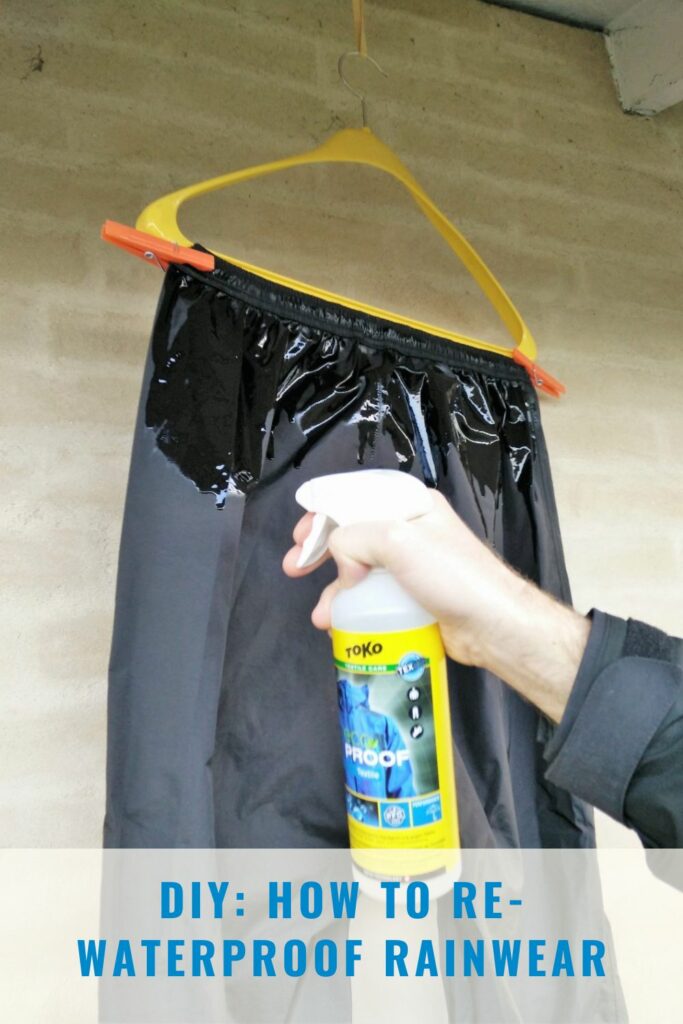

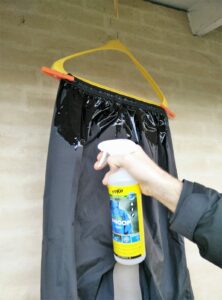
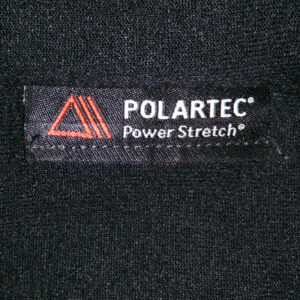
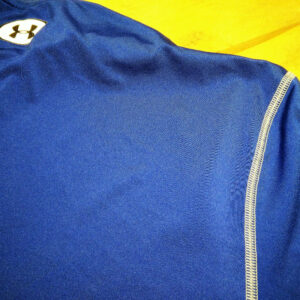
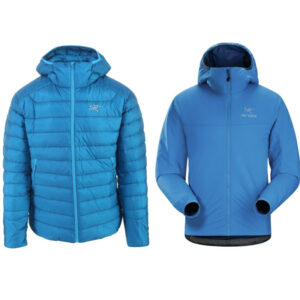
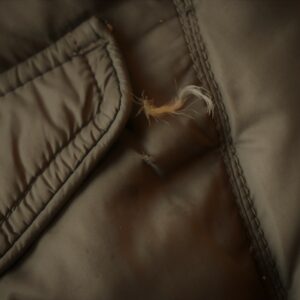
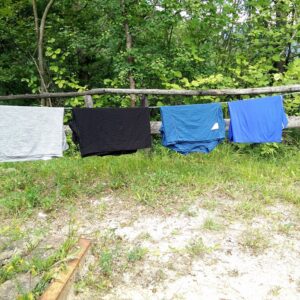
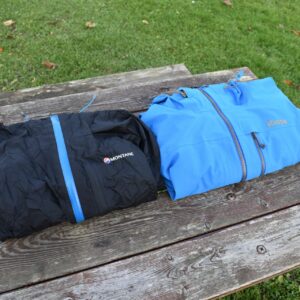















What about the seams?
Hi there,
Quality rainwear typically has taped seams and thus you don’t have to do anything regarding the seams. I don’t think there is a way to prevent rainwear without taped seams from leaking.
Regards,
Blaz
Hi.
Is there any way, that the shiny polyurethane waterproofing inside rain jackets/cagoules can be re-waterproofed where the coating is wearing away, or flaking away? If so what would you recommend for this, as I have some old vintage type ones that are like this. Is it ok to re-waterproof it on the outside or on the inside where the waterproof coating is wearing away to help remedy this?
Thank you. Best wishes and kindest regards,
Steve.
Hi Steve,
You can re-waterproof garments on the outside so they will repel water better. This should increase the waterproofness of the garments to some extent. However, there is no solution for fixing torn coatings on the inside. These are applied to garments in manufacturing process.
Regards,
Blaz